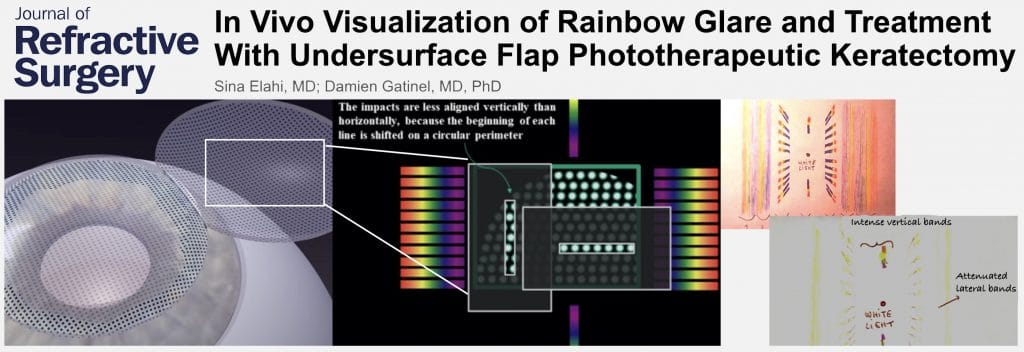In Vivo Visualization of Rainbow Glare and Treatment With Undersurface Flap Phototherapeutic Keratectomy. Elahi S, Gatinel D. J Refract Surg. 2020;36(6):400-404
Rainbow glare (RG) is a rare optical side effect of femtosecond laser-assisted LASIK (FS-LASIK) where patients complain of immediate postoperative rainbow-like glares when exposed to a polychromatic light source such as artificial lights. The presumed hypothesis is that they are caused by a diffractive grating pattern of geometrically-aligned, regularly-spaced femtosecond laser impacts. The crater left by the laser impact may be temporarily filled by various materials, from cavitation bubbles, which may explain the often transient nature of RG.
After the description of the first successful RG treatment by performing a 16-mm planar photoablation of the posterior surface of the flap -or undersurface photoablation, we analyze the case of a unilateral RG which required repeated undersurface photoablation using Wavelight EX-500 (Alcon Laboratories) excimer laser (flap created by Wavelight FS-200 femtosecond laser).
How many microns of back flap photoablation is necessary?
What is the origin of the invariably bright vertical lines with the typical spectral dispersion associated with rainbow glare – whereas the spots are not vertically aligned given that each horizontal line is shifted due to the line-wrap of the circular perimeter?
This paper proposes some answers to these questions.
- Undersurface photoablation is an efficient treatment of RG, and should at least include 15-20 mm thickness.
- The lateral spectral bands constitutive of the diffractive pattern in RG is easily comprehensible when considering the horizontal regular spacing of the femtosecond laser spots. However, there are invariably bright vertical lines with the typical spectral dispersion associated to RG which cannot be explained by the even spot distribution. Since each horizontal line is shifted due to the line-wrap of the circular perimeter, the spots are not vertically aligned. However, the lines created by the spots simulate regularly spaced thin diffractive slits which could explain the origin of the vertical spectral lines.


Les fluctuations de la vision après correction de l’hypermétropie et de la presbytie sont très fréquentes; les causes en sont un peu mystérieuses, elles pourraient être liées à plusieurs conditions rassemblées, et fonction de la luminosité ambiante. La sécheresse oculaire, la présence d’un léger oedème physiologique de la cornée au réveil (puis sa dissipation), tout ceci peut être invoqué.
bonjour docteur
je me suis fait opéré il y a 14 mois par femto-lasik
pour 1 hypermétropie astigmatisme et presbytie
a ce jour chez toujours 1 flou qui persiste encore de loin seulement, par contre la vue de prés est parfaite .
mon médecin me dit que la vue évolue pendant 2 ans et que ce flou va disparaitre …
par contre il y arrive que des jours ma vue est très bonne de loin, mais ça dure 1 ou 2 jours après je revois de nouveau flou
quelle est votre avis svp,?
merci de votre réponse!!!